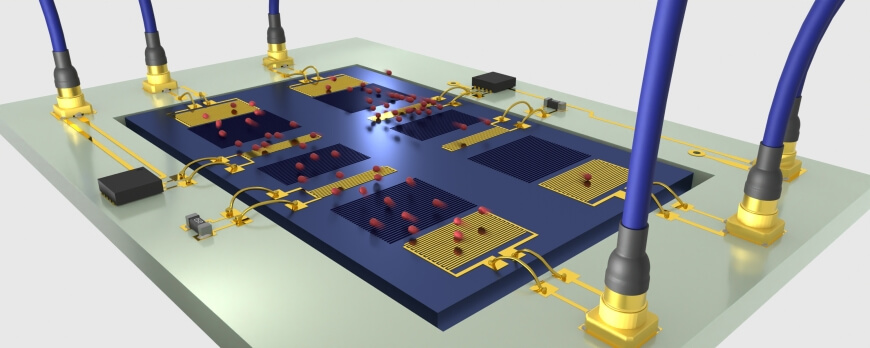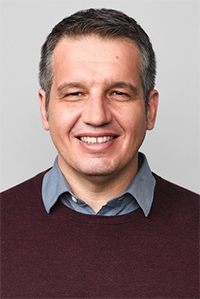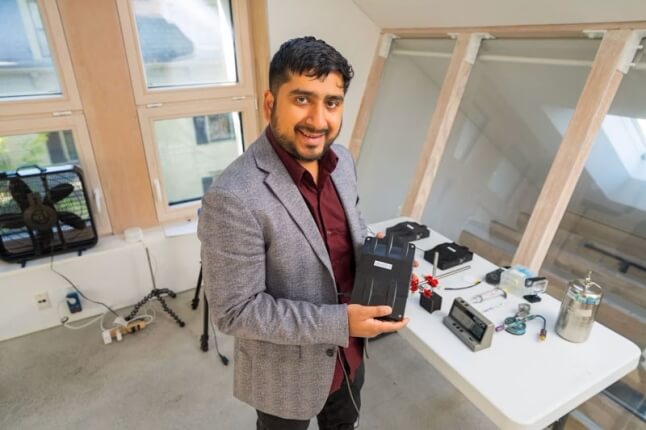News
Schematic illustration of a non-reciprocal surface acoustic wave device. The device, which is built on a lithium niobate platform and contains coupled acoustic resonators, transmits acoustic waves (represented here by red spheres) only in one direction. (Image courtesy of Linbo Shao/Harvard SEAS)
Download ImageIf you can hear your neighbors through a shared wall, you better believe they can hear you too. This has nothing to do with your annunciation and everything to do with a fundamental property of how waves — be they acoustic, light or electric — move through materials. Most media are reciprocal, meaning if a wave can travel from point A to point B, it can also travel from point B to point A at identical frequencies and amplitudes.
This may be advantageous for eavesdroppers, but reciprocity causes all kinds of interference and crosstalk in signal processing. As communications technology gets smaller — and waves get confined in smaller and smaller spaces — devices that can break a signal’s symmetry are increasingly more important. However, most of today’s so-called non-reciprocal acoustic devices are too bulky and difficult to integrate onto chips.
Now, researchers at the Harvard John A. Paulson School of Engineering and Applied Sciences (SEAS) have developed a non-reciprocal device for acoustic waves that could be used in next-generation wireless communication and quantum computing.
The research was published in Nature Electronics.
“Acoustic waves are emerging as a promising as approach for on-chip information carriers for both quantum and classical information processing,” said Marko Loncar, Tiantsai Lin Professor of Electrical Engineering at SEAS and senior author on this work.
Acoustic waves are slower and shorter than their microwave counterparts of the same frequency, and do not readily interact with each other. In classical communications, acoustic wave filters are used in most cell phones to filter frequency bands. Currently, these filters are passive, meaning they can’t be tuned. However, if acoustic wave filters could be tuned, cell phones would have access to a much broader frequency range, which is important as we move towards 5G and 6G telecommunications. In quantum communications, the fact that these waves don’t interact with each other is of interest for quantum applications, where information is carried by individual acoustic waves known as phonons.
In order to use acoustic waves for these applications, there needs to be one-way roads for the signals to travel on. Using a lithium niobite platform, SEAS researchers developed a device that not only breaks the symmetry of acoustic waves but can also tune them.
“The tunability of this device means that it could be used for the manipulation, routing and amplification of signals in a compact, integrated footprint,” said Linbo Shao,a former graduate student and current postdoctoral fellow at SEAS, and first author of the paper.
The device acts a bit like a spike strip in a car rental lot. Two coupled acoustic resonators allow a signal to go in one direction but stop it if it tries to go in reverse. By connecting two of these devices, the researchers demonstrated one-way circulation of acoustic waves — essentially an acoustic roundabout. They also demonstrated — thanks to the particular characteristics of lithium niobite and some electric circuitry — that they could tune the gain, loss and nonlinearity of the system.
This research co-authored by Smarak Maity, Neil Sinclair and Yaowen Hu of Harvard and Wenbo Mao and Lan Yang of Washington University. It was supported in part by the National Science Foundation under grants DMR-1231319 and ECCS-1810233, the Office of Navy Research
MURI, under grant no. N00014-15-1-2761 and the Air Force Office of Scientific Research MURI grant no. FA9550-14-1-0389.
Topics: Applied Physics
Cutting-edge science delivered direct to your inbox.
Join the Harvard SEAS mailing list.
Scientist Profiles
Marko Lončar
Tiantsai Lin Professor of Electrical Engineering
Press Contact
Leah Burrows | 617-496-1351 | lburrows@seas.harvard.edu




